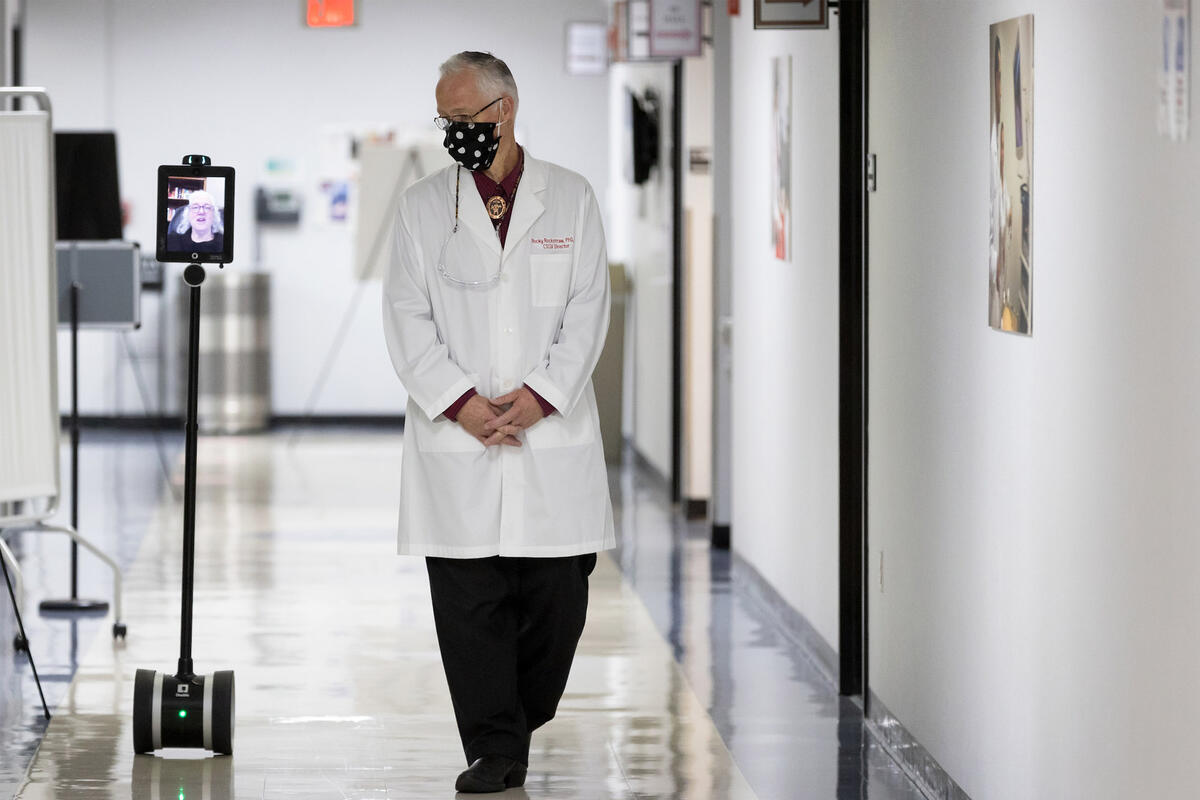A robot walks into a classroom. This isn’t the setup to a joke — it’s day-to-day operations at the Clinical Simulation Center of Las Vegas.
This is the Double robot, a self-driving video-conferencing machine, designed for enhanced remote learning and working. The simulation center, where UNLV nursing and medical students practice their skills through simulated patient interactions, has several of these available for faculty, staff, and students with which to interact.
While it has proved useful during the coronavirus pandemic, the Double robot has a variety of applications to improve education now and in the future.
It's like being right there
The robot is a set of rubber wheels connected by a pole to an iPad "head." It's produced by a company, Double Robotics, that has been making these remote instruction tools for years.
Using a webcam, the robot's pilot can project their face on the screen and use the machine's microphone and speakers to communicate with students.
Though a classroom robot was the perfect fit for keeping professors safe while teaching during a pandemic, School of Nursing Dean Angela Amar first explored bringing them to UNLV when she arrived in 2018.
“Other schools were using Double robots,” she said. “As we investigated, we learned they were originally developed for telecommuting. It meant the person was in the room with you [via iPad] rather than on a screen.”
She concluded the robots would provide multiple advantages for School of Nursing, like allowing instructors to conduct clinical simulation courses remotely; be used for distance site visits; and enhance the presence of faculty who don’t have a UNLV office or who live out of state.
Some UNLV faculty were already familiar with the technology. Karyn Holt, UNLV nursing professor and director of educational quality and innovations, began using Double robots five years ago while teaching at Drexel University in Philadelphia.
“We tried it because I was from Alaska and everybody else was on the East Coast,” Holt said. “It allowed me to roam up and down the halls and go into people’s offices. I could travel between meetings with different faculty members within a building. I could stop and look into a room as well as turn back into the main hallway and walk. It really felt like I was there.”
Rocky Rockstraw, director of the simulation center, previously worked with Holt and the robots at Drexel. He arrived at UNLV in 2020 and helped transition the robots from the Bigelow Health Sciences building to the center, where they are employed more often with wider spaces in which to travel.
A key tool for simulation
While the robots have practical uses in any classroom, it’s at the simulation center where students, faculty, and staff can tailor the technology directly for nursing simulations and teaching.
“There's a much bigger use right now for the students to come in from afar to watch a simulation or to interact with the faculty member as if they were in the sim center,” Holt said.
Timothy Cummings works as a standardized patient trainer, which involves guiding the performances of health actors to better train nursing and medical students. He has used the robot to do his job remotely.
“With the Double robot, I was able to be present with the standardized patients and offer them real-time feedback, even though I was working from home,” he said. “Given our current circumstances, we were considering a time when a health care provider would need to visit with a number of patients who have been exposed to COVID-19. How would they be able to do that safely, rapidly and with increased mobility? The Double robot appears to be a good option to accomplish this."
Overcoming robotic unease
Holt says while the robot helps simulate in-person roles, it should not simply recreate face-to-face settings.
“You really want to find ways to make things happen that are unique and engaging to the students in that online classroom," she said.
The biggest stumbling block, though, is people who don't want to communicate with a robot. “They want to communicate with a person," Holt said. "[It’s about] getting over that whole idea that that's a robot and not really me.”
In her experience, Holt hasn’t seen faculty refuse to work with robot, but says it can be obvious when they're not comfortable, which can have an adverse effect on others.
“I think sometimes this technology is cool to see on TV, but it’s a little awkward when you see it in real life,” Rockstraw, the center's director, said.
Looking into the future, Rockstraw sees the robot experience improving within the next five to 10 years, in many ways prompted by new norms brought on by COVID-19.
Among the advancements he sees regarding clinical simulation include more awareness and usage by faculty, staff and students; and a greater sense of comfort of using robots to interact with simulation center visitors.
But he also sees more facilities adapting to robot access with removing barriers like closed doors; and indoor GPS to find specific locations and people.
“[This] will decrease frustration felt with the novel feeling of use of this technology,” he said.



